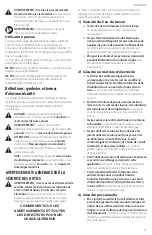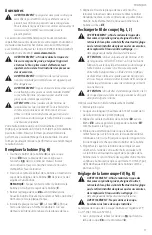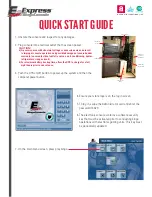
English
8
Cleaning
WARNING:
Blow dirt and dust out of all air vents with
clean, dry air at least once a week. To minimize the risk
of eye injury, always wear ANSI Z87.1 approved eye
protection when performing this procedure.
WARNING:
Never use solvents or other harsh
chemicals for cleaning the non‑metallic parts of the
tool. These chemicals may weaken the plastic materials
used in these parts. Use a cloth dampened only with
water and mild soap. Never let any liquid get inside the
tool; never immerse any part of the tool into a liquid.
MAINTENANCE
WARNING: To reduce the risk of serious personal
injury, turn unit off and remove the battery pack
before making any adjustments or removing/
installing attachments or accessories.
An
accidental start‑up can cause injury.
Your
D
e
WALT
power tool has been designed to operate
over a long period of time with a minimum of maintenance.
Continuous satisfactory operation depends upon proper tool
care and regular cleaning.
WARNING:
Keep the rotating string roughly parallel
with the ground (tilted no more than 30
°
). This trimmer
is not an edger. DO NOT TILT the trimmer so that the
string is spinning near a right angle to the ground.
Flying debris can cause serious injury.
Bump Feed Trimmer Line Feed
Your trimmer uses 0.08" (2.0 mm) diameter nylon line.
Cutting line will wear faster and require more feeding if the
cutting is done along sidewalks or other abrasive surfaces or
heavier weeds are being cut.
As you use the trimmer, the string will get shorter due to
wear. Gently bump the trimmer on the ground while running
at normal speed and the line will feed.
nOTE:
Extending nylon line beyond the 17" (432 mm) swath
will negatively affect performance, runtime, and the life of
the trimmer due to potential of damaging motor. Doing so
may void the warranty.
Helpful Cutting Tips
• Use the tip of the string to do the cutting; do not force
string head into uncut grass.
• Wire and picket fences cause extra string wear, even
breakage. Stone and brick walls, curbs, and wood may
wear string rapidly.
• Do not allow spool cap to drag on ground or
other surfaces.
• In long growth, cut from the top down and do not
exceed 12" (300 mm) high.
• Keep trimmer tilted toward the area being cut; this is the
best cutting area.
• The trimmer cuts when passing the unit from the left to
right. This will avoid throwing debris at the operator.
• Avoid trees and shrubs. Tree bark, wood moldings, siding,
and fence posts can easily be damaged by the string.
Trimming (Fig. E–G)
With the string trimmer on, angle it and swing side to side as
shown in Fig. E, F.
Maintain a minimum distance of 24" (610 mm) between the
guard and your feet as shown in Fig. G.
WARNING:
Hold the tool using only the designated
gripping surfaces: The powerhead handle and the
auxiliary handle.
WARNING:
Do not use the pole as a gripping surface.
Proper hand position requires one hand on the powerhead
handle
11
and one hand on the auxiliary handle
12
.
Proper Hand Position (Fig. D, E)
WARNING:
To reduce the risk of serious personal injury,
ALWAYS
use proper hand position as shown.
WARNING:
To reduce the risk of serious personal
injury,
ALWAYS
hold securely in anticipation of a
sudden reaction.
OPERATION
WARNING: To reduce the risk of serious personal
injury, turn unit off and remove the battery pack
before making any adjustments or removing/
installing attachments or accessories.
An
accidental start‑up can cause injury.
Assembling the Guard (Fig. C)
1. Slide the guard
2
into place as shown in Fig. C.
2. Secure with the guard screws and washers
13
and
washers, tighten securely.
Assembling the String Trimmer
Attachment to the Powerhead (Fig. A, B)
1. The upper powerhead pole
5
is equipped with three
latching holes
8
,
9
,
10
,for the latching button
6
.
2. When installing the string trimmer attachment
1
into
the upper powerhead pole
5
, use the arrows
7
to align
the latching button
6
with latching hole
8
, as shown
in Fig. B.
nOTE:
To properly engage the latching button
6
with
the latching hole
8
, slightly rotate the powerhead
pole
5
and move it axially until the latching button
engages the latching hole.
DO nOT
insert the latching button into latching
hole
9
, or
10
. Doing so will position the string trimmer
attachment in an incorrect orientation which could
create a safety hazard. Latching holes
9
and
10
are for
other attachments.
3. Turn the knob
4
to secure the attachment.
4. When properly assembled, it should look like Fig. B. If
it does not, do not use, disassemble and re-align the
string trimmer attachment
1
so the latching button
6
engages with latching hole
8
as shown in Fig B.
nOTE:
Ensure the attachment is fully engaged and the
knob is fully tightened before operating. Check for proper
engagement and tightness during use.











































